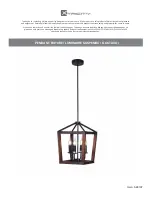
iCAP Customer Familiarisation Manual
Page 64 of 72
This document is part numbered 849940090071
9.2 Poor accuracy/feedback
First we should define accuracy as reproducing the standard value once standardised
Proceed by making a standard as in the previous section (10 ppm Cu, Mn, Cd, Zn, Fe)
and using this as the test solution. Remember we are not defining accuracy for this tes
as the ability to read a 1 or 100 ppm standard after standardising on the 10 ppm. Most of
the time that problem is operator
have only one standard to test with. If this simple standard will not repeat
elements, check the pump winding first. Replace it if it is used or collapsed.
Note: Pump windings typically last only a couple of days
Check the method to see if a fast pump rate is used for the flush period. If it is, then
make the flush pump rate the same as the analysis rate and try it again. Inaccuracy
can sometimes be traced to the inability of the pump tubing to recover its shape
after being stretched.
Check the flush time for adequate rinse time. A 30
most cases but not if a slow pump rate is being used or if a very long piece of tubing
is used (as with the autosampler probe).
9.3 Poor detection
This problem can be also related to
the poor precision problem discussed
earlier and is usually solv
approaching it as such. However, if
the loss of intensities is especially
pronounced at lower wavelengths it
may be due to a dirty window
mounted in the Purged Optical Path.
UV burn or a dirty mirror is
characterised by a long term decline
(six months or longer) of intensities.
iCAP Customer Familiarisation Manual
This document is part numbered 849940090071
Poor accuracy/feedback
First we should define accuracy as reproducing the standard value once standardised
Proceed by making a standard as in the previous section (10 ppm Cu, Mn, Cd, Zn, Fe)
and using this as the test solution. Remember we are not defining accuracy for this tes
as the ability to read a 1 or 100 ppm standard after standardising on the 10 ppm. Most of
the time that problem is operator-related. As far as we are concerned at this point we
have only one standard to test with. If this simple standard will not repeat back for all
elements, check the pump winding first. Replace it if it is used or collapsed.
Note: Pump windings typically last only a couple of days
.
Check the method to see if a fast pump rate is used for the flush period. If it is, then
h pump rate the same as the analysis rate and try it again. Inaccuracy
can sometimes be traced to the inability of the pump tubing to recover its shape
after being stretched.
Check the flush time for adequate rinse time. A 30-second rinse time is adequate
most cases but not if a slow pump rate is being used or if a very long piece of tubing
is used (as with the autosampler probe).
detection limits
This problem can be also related to
problem discussed
earlier and is usually solved by
approaching it as such. However, if
the loss of intensities is especially
pronounced at lower wavelengths it
may be due to a dirty window
mounted in the Purged Optical Path.
UV burn or a dirty mirror is
characterised by a long term decline
s or longer) of intensities.
Version 1.02
First we should define accuracy as reproducing the standard value once standardised
Proceed by making a standard as in the previous section (10 ppm Cu, Mn, Cd, Zn, Fe)
and using this as the test solution. Remember we are not defining accuracy for this test
as the ability to read a 1 or 100 ppm standard after standardising on the 10 ppm. Most of
related. As far as we are concerned at this point we
back for all
elements, check the pump winding first. Replace it if it is used or collapsed.
Check the method to see if a fast pump rate is used for the flush period. If it is, then
h pump rate the same as the analysis rate and try it again. Inaccuracy
can sometimes be traced to the inability of the pump tubing to recover its shape
second rinse time is adequate in
most cases but not if a slow pump rate is being used or if a very long piece of tubing
Содержание iCAP 7000 Series
Страница 36: ...iCAP Customer Familiarisation Manual Page 36 of 72 This document is part numbered 849940090071 Version 1 02 ...
Страница 48: ...iCAP Customer Familiarisation Manual Page 48 of 72 This document is part numbered 849940090071 Version 1 02 ...
Страница 58: ...iCAP Customer Familiarisation Manual Page 58 of 72 This document is part numbered 849940090071 Version 1 02 ...









































